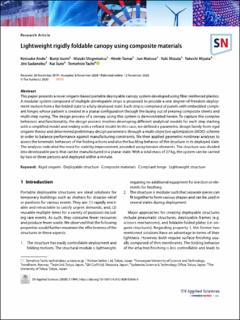| dc.contributor.author | Ando, Kensuke | |
| dc.contributor.author | Izumi, Bunji | |
| dc.contributor.author | Shigematsu, Mizuki | |
| dc.contributor.author | Tamai, Hiroki | |
| dc.contributor.author | Matsuo, Jun | |
| dc.contributor.author | Mizuta, Yuki | |
| dc.contributor.author | Miyata, Takeshi | |
| dc.contributor.author | Sadanobu, Jiro | |
| dc.contributor.author | Suto, Kai | |
| dc.contributor.author | Tachi, Tomohiro | |
| dc.date.accessioned | 2021-02-25T08:49:25Z | |
| dc.date.available | 2021-02-25T08:49:25Z | |
| dc.date.created | 2021-01-15T14:31:31Z | |
| dc.date.issued | 2020 | |
| dc.identifier.citation | SN Applied Sciences. 2020, 1994 (2), . | en_US |
| dc.identifier.issn | 2523-3963 | |
| dc.identifier.uri | https://hdl.handle.net/11250/2730265 | |
| dc.description.abstract | This paper presents a novel origami-based portable deployable canopy system developed using fiber reinforced plastics. A modular system composed of multiple developable strips is proposed to provide a one degree-of-freedom deployment motion from a flat-folded state to a fully deployed state. Each strip is comprised of panels with embedded compliant hinges whose pattern is created in a planar configuration through the laying out of prepreg composite sheets and multi-step curing. The design process of a canopy using this system is demonstrated herein. To capture the complex behaviors and functionality, the design process involves developing different analytical models for each step starting with a simplified model and ending with a refined model. In this case, we defined a parametric design family from rigid origami theory and determined preliminary design parameters through a multi-objective optimization (MOO) scheme in order to balance performance against manufacturing constraints. We then applied geometric nonlinear analyses to assess the kinematic behaviors of the folding actions and also the buckling behavior of the structure in its deployed state. The analyses indicated the need for stability improvement, provided using tension elements. The structure was divided into developable parts that can be manufactured in a planar state. With a total mass of 27 kg, the system can be carried by two or three persons and deployed within a minute. | en_US |
| dc.language.iso | eng | en_US |
| dc.publisher | Springer | en_US |
| dc.rights | Navngivelse 4.0 Internasjonal | * |
| dc.rights.uri | http://creativecommons.org/licenses/by/4.0/deed.no | * |
| dc.title | Lightweight rigidly foldable canopy using composite materials | en_US |
| dc.type | Peer reviewed | en_US |
| dc.type | Journal article | en_US |
| dc.description.version | publishedVersion | en_US |
| dc.source.pagenumber | 15 | en_US |
| dc.source.volume | 1994 | en_US |
| dc.source.journal | SN Applied Sciences | en_US |
| dc.source.issue | 2 | en_US |
| dc.identifier.doi | https://doi.org/10.1007/s42452-020-03846-0 | |
| dc.identifier.cristin | 1872192 | |
| dc.description.localcode | Open Access This article is licensed under a Creative Commons Attribution 4.0 International License, which permits use, sharing, adaptation, distribution and reproduction in any medium or format, as long as you give appropriate credit to the original author(s) and the source, provide a link to the Creative Commons licence, and indicate if changes were made. The images or other third party material in this article are included in the article's Creative Commons licence, unless indicated otherwise in a credit line to the material. If material is not included in the article's Creative Commons licence and your intended use is not permitted by statutory regulation or exceeds the permitted use, you will need to obtain permission directly from the copyright holder. To view a copy of this licence, visit http://creativecommons.org/licenses/by/4.0/. | en_US |
| cristin.ispublished | true | |
| cristin.fulltext | postprint | |
| cristin.qualitycode | 1 | |

